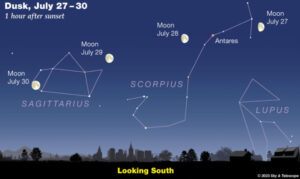Special to CosmicTribune.com, July 27, 2023
Excerpts from weekly Sky&Telescope report.
SATURDAY, JULY 29
■ The Moon hangs just off the spout of the Sagittarius Teapot this evening.

MONDAY, JULY 31
■ The two brightest stars of summer are Vega, overhead shortly after nightfall, and Arcturus, shining in the west.
TUESDAY, AUGUST 1
■ Full Moon (exact at 2:23 p.m.) in southern Capricornus. As twilight fades, look for Altair very high over it. Once the Moon is nicely up, look for Saturn two fists at arm’s length to its left.
WEDNESDAY, AUGUST 2
■ The Moon, now just a day and a fraction past full, rises in late twilight. This evening look for Saturn about 6° to the Moon’s left or upper left. They’ll draw closer through the night as they wheel across the sky together.
■ We’re not quite halfway through summer, but already W-shaped Cassiopeia, a high constellation of fall and winter evenings, is climbing up in the north-northeast as evening grows late.
 THURSDAY, AUGUST 3
THURSDAY, AUGUST 3
■ The waning gibbous Moon rises around the very end of twilight. Saturn glows to its upper right.
PLANETS THIS WEEK
Mercury and Venus are very deep in the glow of sunset. Early in the week, use binoculars about 15 or 20 minutes after sunset to start looking for them low above the horizon due west.
On July 28th Mercury is 6° above Venus. It moves farther away, to 15° upper left of Venus by August 4th, but by then Venus is just plain gone from post-sunset view.
Venus in a telescope is entering its most extreme crescent phase, when its hair-thin cusps start extending around the planet’s circumference toward forming a complete ring. The time to examine Venus telescopically now is in the blue sky of afternoon, when it and the Sun are still high. But when looking for Venus take care not to accidentally sweep up the Sun! Keep your eye safe by setting up your scope at a spot where the Sun has just sunk behind a solid, level obstruction, such as the roofline of a house.
Jupiter (magnitude –2.4, in Aries) rises around midnight or a little after in the east-northeast. By the beginning of dawn it shines very high toward the southeast.

You must be logged in to post a comment Login